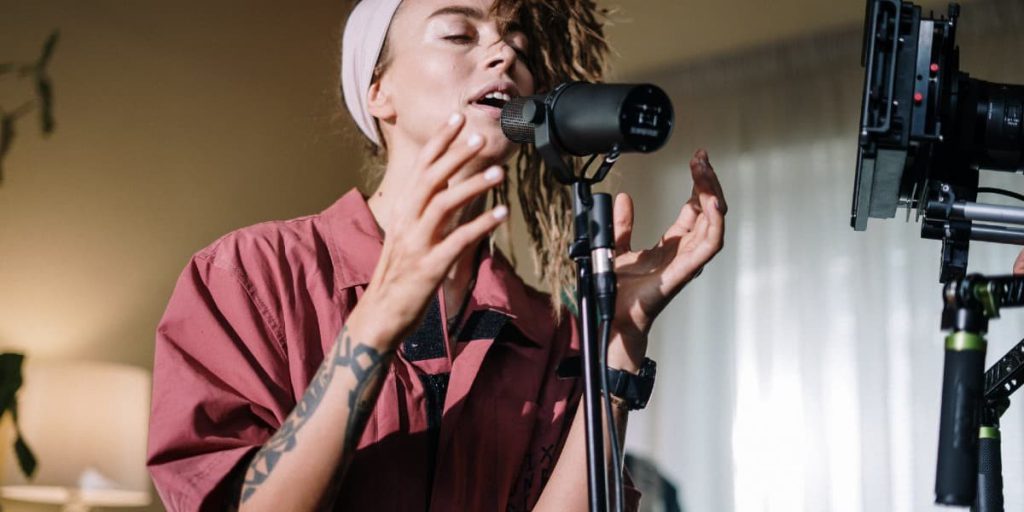May 26, 2020
Live events are a major source of revenue for artists. In this article, we look at the ways artists are using technology to continue performing and the future of live streaming.

Early music industry predictions for 2020 forecasted record levels of revenue. However unprecedented global restrictions have challenged the music industry greatly. Goldman Sachs now predicts there could be a total loss of 25% across the industry in 2020 (MusicAlly, 2020). All facets of the music industry have felt these effects with live events being postponed, album launches being pushed back and music streaming fluctuations. Following an initial decline in streaming reported in March, a month later Spotify shared that streaming levels are rising again and normalizing. Despite these challenges, the music industry has become creative in its approach. This is sure to continue into the future, in particular for the live music sector.
Despite generating royalties from streaming, for many artists live music is their biggest revenue source. Streaming and social media have provided artists with access to global audiences. These fans allow them to tour the world – selling tickets, experiences and merchandise. Pollstar had forecasted the top 100 tours globally to generate $12.2 billion in 2020 (Pollstar, 2020). Beyond these top 100 tours, millions of dollars were due to be generated for artists. Due to global restrictions, this industry came to an immediate halt almost overnight. Pollstar has predicted a box office loss of $8.9 billion if concerts could not be held for the rest of 2020. For both independent and global artists, the cancellation of live tours and events will have a major effect on their earnings. This state of play may continue for many months, and so the live industry is looking at new ways to entertain audiences and create revenue.
The rise of live streaming
To overcome these challenges, artists are adapting to performing in a socially distant world. Technology and online streaming will play a major role in this transformation. Reports this week in The Verge share that the live-streaming sector, across entertainment types, grew by 45% in the past two months (The Verge, 2020). Music and performance content streaming is one of the leading growth categories.
Instagram Live spikes in popularity
Instagram reported an incredible 70% increase in live streaming in the US (Business Insider, 2020). This, of course, is not all music artists but many artists are leveraging this platform. Beyond the ability to easily share live performances, Instagram is providing artists with a way to maintain and solidify their relationships with their global fanbase. Artists are sharing more about themselves and many are “going live” with other artists, which can help them reach new audiences. Artists such as James Vincent McMorrow have been doing live performances and Q&A videos on Instagram since March. Artists who have released music recently have also leveraged social media well to promote their songs.
Global collaboration online
Video platforms have provided opportunities for collaborations between artists themselves, industry groups and live music broadcasters. One such example is the Boiler Room, an online broadcast platform sharing electronic DJs live events from around the world, who launched their “Streaming from Isolation” series on YouTube. This new series which sees popular DJs stream live on YouTube from their homes has garnered millions of views and fundraised money for the World Food Bank. With festivals cancelled this is an excellent way for artists to stay connected to their fans. Another collaboration was the One World: Together at home concert which featured many famous artists. The concert was on TV but also streamed online.
Music and gaming
Artists have also leveraged gaming communities and technologies to share virtual concerts. One such is Twitch, used predominantly as a gaming video streaming platform, which saw huge numbers of people viewing the content in the music and performing arts category. Since the beginning of March over 574,000 hours of music and performing arts content was viewed. This can be attributed to the number of artists choosing to stream on this platform, from club DJs to global musicians. One benefit of live streaming on Twitch is its tipping functionality which provides a revenue stream for artists. Some artists are leveraging online games to integrate live performances. On Minecraft, the “Block by Blockwest” concert, inspired by SXSW, attracted thousands of users (Variety, 2020). While in a major collaboration with Fortnite, Travis Scott performed a live concert within the game in front of over 12.3 million players. This set a record for the largest attendance at an in-game event.

World tours online
It is expected that the short term future of live music will be technology driven, with many industry experts discussing the possibilities of virtual concerts and tours. Brad Serling the founder of concert streaming platform Nugs.net shared that many artists have reached out to discuss their options (Variety, 2020). He shared the concept of virtual tours, where concerts streams are geo-fenced to mirror a global touring schedule. They have the equipment in place within venues to broadcast these high quality concert experiences. In addition, Ari Evans of Maestro, a live streaming company, highlighted the possibility of incorporating virtual fan exclusive experiences similar to that at live concerts (Variety, 2020). While there have been some discussions about social distance events and drive in concerts, live streaming technology could help artists to supplement the loss of international tours.
Royalty matching is vital
Through streaming technology, artists will continue to find creative ways to reach and engage their fans. However with the impact restrictions will have on the live performance sector for an unknown period of time, their incomes are sure to be reduced. Therefore it is very important that royalties are matched accurately. The Matching Engine can help organisations achieve this. Built on Azure and Databricks technologies, this application ensures CMO’s systems can manage and match complex data and various volumes.
Talk to the Matching Engine team today to discuss your matching systems and processes.